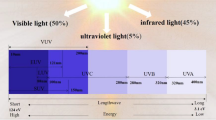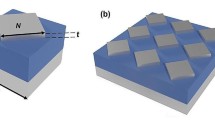Abstract
Comprehensive model for the design of highly reflecting distributed Bragg reflectors (DBRs) is investigated for spectral band, ranging from ultraviolet to short wavelength infrared (SWIR). The reflectivity calculation is done using thin film multiple reflection technique. The variation of reflectivity as a function of wavelength, number of grown epilayers, angle of incidence and difference between refractive indices of constituent epilayers is examined. The target wavelengths for reflectivity simulation include 1.55 and 1.3 μm for optical communication, 850 and 980 nm for infrared (IR) imaging devices and chip-scale atomic clocks, and 412 and 443 nm for UV light emitting diodes and antireflection coatings for charge-coupled devices and solar cells. The reflectivity values calculated for compound semiconductor DBRs lie between 95 and 99%. It is also inferred that the reflectivity of grown epilayers and broadness of operational spectrum increases with number of epilayers. If DBR stack is grown on lattice mismatched substrate, increment of the reflectivity is found only at single wavelength. As the angle of incidence increases from 0° to 80°, blue shift in reflectance (towards low wavelength) is also observed. The increase in reflectivity is also observed with increase in difference in refractive indices of epilayers.







Similar content being viewed by others
References
Iga K 2000 IEEE J. Sel. Top. Quantum Electron 6 1201
Iga K, Kambayashi T and Kitahara C 1978 Proc. 26th Spring Meeting Appl. Phys. Soc. 27p-C-11 63
Goyal P, Gupta S and Kaur G 2016 International conference on electrical, electronics, and optimization techniques (ICEEOT) p 4240
Gibbon T B, Prince K, Pham T T, Tatarczak A, Neumeyr C, Rönnebeg E et al 2011 Opt. Fiber Technol. 17 41
Schnitzer P, Grabherr M, Jager R, Mederer F, Michalzik R, Wiedenmann D et al 1999 IEEE Photon Technol. Lett. 11 767
Mescher M J, Lutwak R and Varghese M 2005 13th International conference on solid-state sensors, actuators and microsystems 1 311
Knappe S, Schwindt P D D, Shah V, Hollberg L, Kitching J, Liew L et al 2005 Opt. Express 13 1249
Jewell J L, Scherer A, McCall S L, Lee Y H, Walker S, Harbison J P et al 1989 Electron. Lett. 25 1123
Matsui Y, Schatz R, Pham T, Ling W A, Carey G, Daghighian H M et al 2017 J. Lightwave Technol. 35 397
Saylan S, Milakovich T, Hadi S A, Nayfeh A, Fitzgerald E A and Dahlem M S 2015 Sol. Energy 122 76
Knopp K J, Mirin R P, Bertness K A, Silvermanal K L and Christensen D H 2000 J. Appl. Phys. 87 7169
Welser R E, Sood A K, Hubbard S M, Polly S J and Montgomery K H 2018 36th Space power workshop, Los Angeles
Jiang Y, Keevers M J and Green M A 2018 IEEE 7th World conference on photovoltaic energy conversion (WCPEC), Hawaii, p 901
Wu C J, Kuo C Y, Wang C J, Chang W E, Tsai C L, Lin C F et al 2020 ACS Appl. Nano Mater. 3 399
Wei B, Han Y, Wang Y, Zhao H, Sun B, Yang X et al 2020 RSC Adv. 10 23341
Alias M S and Hassan A A M 2004 ECS J. Solid State Sci. Technol. 12 120
Oshikiri M, Koyama F and Iga K 1991 Electron. Lett. 27 2038
Tanobe H, Oshikiri M, Araki M, Koyama F and Iga K 1992 Proc. IEEE Lasers Electro-Optics Soc, p 532
Michalzik R and Ebeling K J 1993 IEEE J. Quantum Electron. 29 1963
Streubel K J, Rapp S, Andre J and Wallin J 1996 IEEE Photon. Technol. Lett. 9 1121
Deppe D G, Gerrard N D, Pinzone C J, Dupuis R D and Schubert E F 1990 Appl. Phys. Lett. 56 315
Born M and Wolf E 1959 Principles of optics 1st edn (London: Pergamon Press Ltd.) p 61
Acknowledgements
We are thankful to Director, SCL, for his constant help and support for this project. We gratefully acknowledge the fruitful discussions with Mr H S Jatana, Group Head, Device Processing Group, Mr Sudipto Das Gupta, Dy. Head, Optical Process Development Division, Dr Saumya Sengupta, Dr Manish Verma and Dr Sona Das in-understanding concepts of III–V compound semiconductors and optics.
Author information
Authors and Affiliations
Corresponding author
Supplementary Information
Below is the link to the electronic supplementary material.
Rights and permissions
Springer Nature or its licensor (e.g. a society or other partner) holds exclusive rights to this article under a publishing agreement with the author(s) or other rightsholder(s); author self-archiving of the accepted manuscript version of this article is solely governed by the terms of such publishing agreement and applicable law.
About this article
Cite this article
Sharma, R.K., Gupta, S.D., Jatana, H.S. et al. Effect of optical parameters on design of highly reflecting distributed Bragg reflectors based on compound semiconductors for space applications. Bull Mater Sci 44, 63 (2021). https://doi.org/10.1007/s12034-021-02356-y
Received:
Accepted:
Published:
DOI: https://doi.org/10.1007/s12034-021-02356-y




